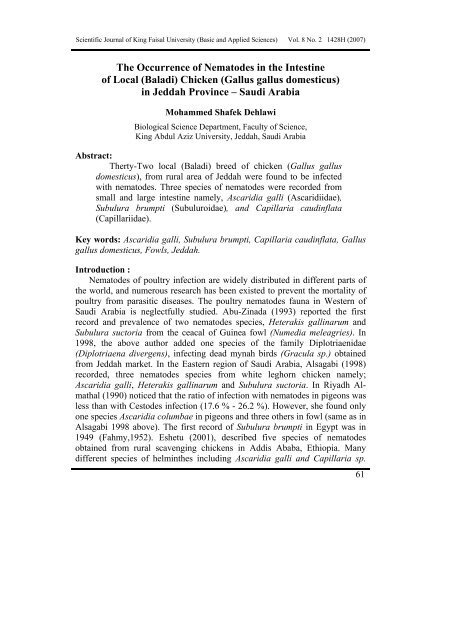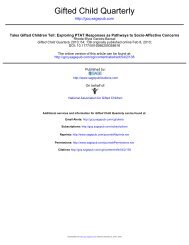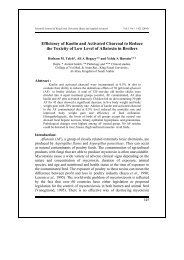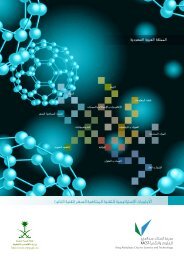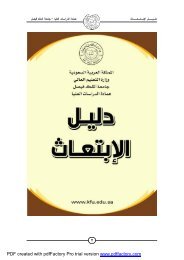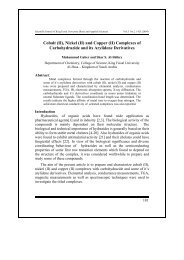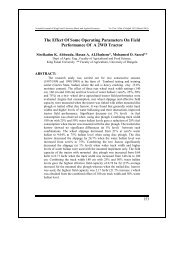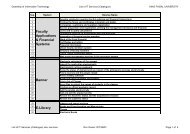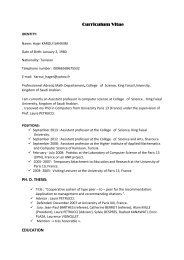The Occurrence of Nematodes in the Intestine of Local (Baladi ...
The Occurrence of Nematodes in the Intestine of Local (Baladi ...
The Occurrence of Nematodes in the Intestine of Local (Baladi ...
You also want an ePaper? Increase the reach of your titles
YUMPU automatically turns print PDFs into web optimized ePapers that Google loves.
Scientific Journal <strong>of</strong> K<strong>in</strong>g Faisal University (Basic and Applied Sciences) Vol. 8 No. 2 1428H (2007) <strong>The</strong> <strong>Occurrence</strong> <strong>of</strong> <strong>Nematodes</strong> <strong>in</strong> <strong>the</strong> Intest<strong>in</strong>e<strong>of</strong> <strong>Local</strong> (<strong>Baladi</strong>) Chicken (Gallus gallus domesticus)<strong>in</strong> Jeddah Prov<strong>in</strong>ce – Saudi ArabiaMohammed Shafek DehlawiBiological Science Department, Faculty <strong>of</strong> Science,K<strong>in</strong>g Abdul Aziz University, Jeddah, Saudi ArabiaAbstract:<strong>The</strong>rty-Two local (<strong>Baladi</strong>) breed <strong>of</strong> chicken (Gallus gallusdomesticus), from rural area <strong>of</strong> Jeddah were found to be <strong>in</strong>fectedwith nematodes. Three species <strong>of</strong> nematodes were recorded fromsmall and large <strong>in</strong>test<strong>in</strong>e namely, Ascaridia galli (Ascaridiidae),Subulura brumpti (Subuluroidae), and Capillaria caud<strong>in</strong>flata(Capillariidae).Key words: Ascaridia galli, Subulura brumpti, Capillaria caud<strong>in</strong>flata, Gallusgallus domesticus, Fowls, Jeddah.Introduction :<strong>Nematodes</strong> <strong>of</strong> poultry <strong>in</strong>fection are widely distributed <strong>in</strong> different parts <strong>of</strong><strong>the</strong> world, and numerous research has been existed to prevent <strong>the</strong> mortality <strong>of</strong>poultry from parasitic diseases. <strong>The</strong> poultry nematodes fauna <strong>in</strong> Western <strong>of</strong>Saudi Arabia is neglectfully studied. Abu-Z<strong>in</strong>ada (1993) reported <strong>the</strong> firstrecord and prevalence <strong>of</strong> two nematodes species, Heterakis gall<strong>in</strong>arum andSubulura suctoria from <strong>the</strong> ceacal <strong>of</strong> Gu<strong>in</strong>ea fowl (Numedia meleagries). In1998, <strong>the</strong> above author added one species <strong>of</strong> <strong>the</strong> family Diplotriaenidae(Diplotriaena divergens), <strong>in</strong>fect<strong>in</strong>g dead mynah birds (Gracula sp.) obta<strong>in</strong>edfrom Jeddah market. In <strong>the</strong> Eastern region <strong>of</strong> Saudi Arabia, Alsagabi (1998)recorded, three nematodes species from white leghorn chicken namely;Ascaridia galli, Heterakis gall<strong>in</strong>arum and Subulura suctoria. In Riyadh Almathal(1990) noticed that <strong>the</strong> ratio <strong>of</strong> <strong>in</strong>fection with nematodes <strong>in</strong> pigeons wasless than with Cestodes <strong>in</strong>fection (17.6 % - 26.2 %). However, she found onlyone species Ascaridia columbae <strong>in</strong> pigeons and three o<strong>the</strong>rs <strong>in</strong> fowl (same as <strong>in</strong>Alsagabi 1998 above). <strong>The</strong> first record <strong>of</strong> Subulura brumpti <strong>in</strong> Egypt was <strong>in</strong>1949 (Fahmy,1952). Eshetu (2001), described five species <strong>of</strong> nematodesobta<strong>in</strong>ed from rural scaveng<strong>in</strong>g chickens <strong>in</strong> Addis Ababa, Ethiopia. Manydifferent species <strong>of</strong> helm<strong>in</strong><strong>the</strong>s <strong>in</strong>clud<strong>in</strong>g Ascaridia galli and Capillaria sp.61
<strong>The</strong> <strong>Occurrence</strong> <strong>of</strong> <strong>Nematodes</strong> <strong>in</strong> <strong>the</strong> Intest<strong>in</strong>e <strong>of</strong> <strong>Local</strong> (<strong>Baladi</strong>) Chicken …Mohammed Sh. Dehlawiwere found <strong>in</strong> <strong>the</strong> <strong>in</strong>test<strong>in</strong>al tract <strong>of</strong> <strong>in</strong>digenous poultry <strong>in</strong> parts <strong>of</strong> Kenya(Irungu et.al, 2004). Barus and Son<strong>in</strong> (1980), described two species <strong>of</strong> <strong>the</strong>genus, Subulura; S. skrjab<strong>in</strong>i and S. brumpti parasitiz<strong>in</strong>g Corturnix(Galliformes) <strong>in</strong> India. A total <strong>of</strong> 18 species were detected from 100 chickens<strong>in</strong> Ghana to determ<strong>in</strong>e <strong>the</strong> prevalence and distribution <strong>of</strong> <strong>in</strong>test<strong>in</strong>al helm<strong>in</strong><strong>the</strong>s(Poulsen et.al 2000). El-Khawed et.al (1977) identified and exhibited 87% <strong>of</strong><strong>the</strong> hens with mono–and poly<strong>in</strong>fections, <strong>of</strong> helm<strong>in</strong><strong>the</strong>s <strong>in</strong>clud<strong>in</strong>g S. brumti <strong>in</strong>Khartoum, Sudan.To my knowledge, <strong>the</strong>se nematodes have not been recorded from <strong>the</strong> local(<strong>Baladi</strong>) chicken <strong>in</strong> Jeddah area.Materials and Methods:A total <strong>of</strong> 32 female local (<strong>Baladi</strong>) (Gallus gallus domesticus) breedchickens were purchased from Jeddah market dur<strong>in</strong>g <strong>the</strong> fall and w<strong>in</strong>ter <strong>of</strong>2004. <strong>The</strong>y were orig<strong>in</strong>ated from Jeddah district and its rural area such as, El-Khomrah, Ghran and Om-Jabala<strong>in</strong> villages. On return to laboratory, <strong>the</strong> birdswere sacrificed and <strong>the</strong> <strong>in</strong>test<strong>in</strong>e (small & large) tracts were removed, slit and<strong>in</strong>cubated <strong>in</strong> warm normal sal<strong>in</strong>e (35-40 o C) for two hours. Recoverdnematodes were placed <strong>in</strong> distilled water for few m<strong>in</strong>utes to wash and relax,<strong>the</strong>n counted us<strong>in</strong>g a dissect<strong>in</strong>g microscope. Male and female worms wereseparated, fixed immediately <strong>in</strong> 70% ethanol and reta<strong>in</strong>ed for sta<strong>in</strong><strong>in</strong>gprocesses. Us<strong>in</strong>g standard techniques, worm specimens were dehydrated,sta<strong>in</strong>ed, cleared <strong>in</strong> lactophenol solution (Schmidt 1992) and mounted <strong>in</strong>Berlese’s media (Humason 1979). <strong>The</strong>y were diagnosed and identified byus<strong>in</strong>g Schmidt’s (1992), Soulsby’s (1982) and Andreson’s (1992) schematickey <strong>of</strong> nematodes families, genera and species.Results:<strong>Nematodes</strong> <strong>in</strong>fections were found <strong>in</strong> <strong>the</strong> small and large (caecum) <strong>in</strong>test<strong>in</strong>es <strong>of</strong>19 female local (<strong>Baladi</strong>) chicken Gallus gallus domesticus out <strong>of</strong> 32 chickens.Three nematode species were identified. <strong>The</strong>ir systematic scheme anddiagnostic characters are as follow:-1. Ascaridia galli ( Schrank, 1788), Family: Ascaridiidae.Prevalence: <strong>in</strong> 11 out <strong>of</strong> 32 (Table 1)Diagnostic characters: large nematodes, <strong>the</strong> male 9.3 cm female 12.0 cmlong. Three large lips, esophagus 3.3 cm. <strong>The</strong> tale <strong>of</strong> <strong>the</strong> male has smallalae and bears numbers <strong>of</strong> cloacal papillae (5-10 pairs). <strong>The</strong>re is circularcloacal sucker (pre-anal suckers) and two equal spicules (Fig.1).62
Scientific Journal <strong>of</strong> K<strong>in</strong>g Faisal University (Basic and Applied Sciences) Vol. 8 No. 2 1428H (2007) 2. Subulura brumpti (Lopez-Neyra,1922) (Family: Subuluridae )Prevalence: <strong>in</strong> 4 out <strong>of</strong> 32 ( Table 1)Diagnostic characters: small nematodes, <strong>the</strong> male 9.26 mm female 11.38mm long. Buccal capsule is small with three m<strong>in</strong>ute teeth. <strong>The</strong> esophagushas small swell<strong>in</strong>g posteriorly, followed by a deep constriction and <strong>the</strong>n aspherical bulb. <strong>The</strong> tail <strong>of</strong> <strong>the</strong> male is provided with large lateral alae and iscurved ventrally. <strong>The</strong> pre-anal sucker is an elongate slit. <strong>The</strong>re are number<strong>of</strong> pairs <strong>of</strong> small caudal papillae. <strong>The</strong> spicules are equal and alate. <strong>The</strong>vulva is situated just anterior to <strong>the</strong> middle <strong>of</strong> <strong>the</strong> body. (Fig.2)3. Capillaria caud<strong>in</strong>flata (Mol<strong>in</strong>,1858). (Family: Capillariidae).Prevalence: <strong>in</strong> 4 out <strong>of</strong> 32 (Table 1)Diagnostic characters: small nematodes, <strong>the</strong> male 9.2 mm female 15.8 mmlong. Body is <strong>in</strong> two parts, <strong>the</strong> anterior part is longer and th<strong>in</strong>ner (threadlike)which has slender (tube-like) esophagus without bulb. <strong>The</strong> esophagusis shorter <strong>in</strong> male 3.1 mm than female 5.8 mm, lips absent but has onespicule. Anus toward <strong>the</strong> end <strong>of</strong> <strong>the</strong> posterior part. <strong>The</strong> vulva is beh<strong>in</strong>d <strong>the</strong>esophagus-<strong>in</strong>test<strong>in</strong>al junction. <strong>The</strong> posterior end is bluntly rounded anddull. Eggs are oval <strong>in</strong> shape with two opercula, one at each end. (Fig.3).Discussion:<strong>The</strong> most dreadful and debilitat<strong>in</strong>g parasitic diseases <strong>of</strong> domestic animal,specially chickens and o<strong>the</strong>r poultry animals caused by nematodes species. In<strong>the</strong> present study one <strong>of</strong> <strong>the</strong> nematodes species, Ascaridia galli has acosmopolitan distribution as a parasite <strong>of</strong> poultry. Its prevalence was 34.4%which represent a double <strong>of</strong> each <strong>of</strong> <strong>the</strong> two o<strong>the</strong>r species 12.5% for Subulurabrumpti, and 12.5% for Capillaria caud<strong>in</strong>flata. Of <strong>the</strong> specimens exam<strong>in</strong>ed, 19chickens had parasites, whereas <strong>the</strong> rema<strong>in</strong><strong>in</strong>g 13 had none, which gave an<strong>in</strong>fection rate <strong>of</strong> 60% (Table 1). Although this ratio very much correspondswith <strong>the</strong> survey <strong>in</strong> Thailand (Ehlers-Bhodigen 1985) and with <strong>in</strong>cidences <strong>of</strong><strong>in</strong>test<strong>in</strong>al parasite <strong>in</strong> Pakistan (Hayat and Hayat 1983), it was not as high as <strong>in</strong>Kenya (Irungu et al, 2004) and <strong>in</strong> Ethiopia (Eshetu et al, 2001), whereas <strong>in</strong>Ghana West Africa all <strong>the</strong> exam<strong>in</strong>ed chickens (100%) were <strong>in</strong>fected withgastro-<strong>in</strong>test<strong>in</strong>al helm<strong>in</strong><strong>the</strong>s (Poulsen et al, 2000). In <strong>the</strong> mean time, <strong>the</strong><strong>in</strong>tensity records <strong>of</strong> Subulura brumti and Capillaria caud<strong>in</strong>flata were muchhigher than Ascaridia galli <strong>in</strong> each <strong>in</strong>fected chickens (Table 1). <strong>The</strong>relationship between worms sex (male and female) and <strong>the</strong>ir <strong>in</strong>tensity was notsignificant.63
<strong>The</strong> <strong>Occurrence</strong> <strong>of</strong> <strong>Nematodes</strong> <strong>in</strong> <strong>the</strong> Intest<strong>in</strong>e <strong>of</strong> <strong>Local</strong> (<strong>Baladi</strong>) Chicken …Mohammed Sh. DehlawiMuch has been written regard<strong>in</strong>g diseases occur <strong>in</strong> domestic, farm-raisedpoultry. Only two <strong>of</strong> many diseases are notifiable and subject to governmentalcontrol; <strong>the</strong> avian <strong>in</strong>fluenza and Newcastle disease (ND) (Kaleta 1997). ND isa limit<strong>in</strong>g factor for <strong>in</strong>creas<strong>in</strong>g poultry production <strong>in</strong> many tropical countries,where frequent reports <strong>in</strong>dicate vacc<strong>in</strong>ation failures. In Denmark (Horn<strong>in</strong>g atel (2003) <strong>in</strong>vestigated <strong>the</strong> <strong>in</strong>fluence <strong>of</strong> <strong>Nematodes</strong> species Ascaridia galli onvacc<strong>in</strong>ated chickens aga<strong>in</strong>st ND virus under village conditions.Vacc<strong>in</strong>at<strong>in</strong>g poultry naturally <strong>in</strong>fected with helm<strong>in</strong>th parasites or <strong>in</strong>fectedwith Ascaridia galli post- vacc<strong>in</strong>ation aga<strong>in</strong>st ND has proven to produce asignificantly lower immunity aga<strong>in</strong>st ND than <strong>in</strong> poultry which is parasite-free(Glukhor 1984).<strong>The</strong>se three present species are parasites <strong>of</strong> major cl<strong>in</strong>ical importance forpoultry. <strong>The</strong>ir records <strong>in</strong> Saudi Arabia <strong>the</strong>refore very important from veter<strong>in</strong>arypo<strong>in</strong>t <strong>of</strong> view. <strong>The</strong> loss <strong>of</strong> chickens weight and general weakness could affect<strong>the</strong> production losses and death. Due to <strong>the</strong> great value <strong>of</strong> poultry production<strong>in</strong> <strong>the</strong> K<strong>in</strong>gdom <strong>of</strong> Saudi Arabia. Fur<strong>the</strong>r study is needed. 64
Scientific Journal <strong>of</strong> K<strong>in</strong>g Faisal University (Basic and Applied Sciences) Vol. 8 No. 2 1428H (2007) <strong>The</strong> voucherspeciesAscaridiagalliSubulurabrumptCapillariacaud<strong>in</strong>flataTable ( 1 )<strong>The</strong> prevalence and <strong>in</strong>tensity <strong>of</strong> <strong>the</strong> nematodesspecies <strong>in</strong> local (<strong>Baladi</strong>) breed chickenNo. <strong>of</strong> <strong>in</strong>fectedchicken%11 34.44 12.54 12.5Number <strong>of</strong> worms <strong>in</strong> eachchickenTotalMF1 + 2 33 + 8 112 + 6 86 + 7 131 + 3 45 + 5 102 + 4 61 + 1 20 + 1 10 + 2 23 + 3 624 + 42 6613 + 32 456 + 16 225 + 11 169 + 15 2433 + 74 10716 + 20 3611 + 22 333 + 12 154 + 11 1534 + 70 10465
<strong>The</strong> <strong>Occurrence</strong> <strong>of</strong> <strong>Nematodes</strong> <strong>in</strong> <strong>the</strong> Intest<strong>in</strong>e <strong>of</strong> <strong>Local</strong> (<strong>Baladi</strong>) Chicken …Mohammed Sh. Dehlawi Fig. 1 Ascaridia galli: A. ventral view <strong>of</strong> <strong>the</strong> anterior portion show<strong>in</strong>g <strong>the</strong>esophagus. B. Ventral view <strong>of</strong> <strong>the</strong> mouth show<strong>in</strong>g <strong>the</strong> three lips. C & D Lateralview <strong>of</strong> posterior tail <strong>of</strong> male show<strong>in</strong>g <strong>the</strong> alae and <strong>the</strong> spicules. E <strong>The</strong> posteriorend <strong>of</strong> <strong>the</strong> female.66
Scientific Journal <strong>of</strong> K<strong>in</strong>g Faisal University (Basic and Applied Sciences) Vol. 8 No. 2 1428H (2007) Fig. 2 Subulura brumpti: A. view <strong>of</strong> <strong>the</strong> anterior end show<strong>in</strong>g <strong>the</strong> buccal capsule withteeth at <strong>the</strong> base. B. <strong>the</strong> anterior portion show<strong>in</strong>g <strong>the</strong> esophagus with balb. C. <strong>The</strong>posterior end <strong>of</strong> <strong>the</strong> famale. D. <strong>The</strong> lateral curved alae at <strong>the</strong> posterior end <strong>of</strong> <strong>the</strong> maleshow<strong>in</strong>g <strong>the</strong> pre-cloacal sucker and spicules.67
<strong>The</strong> <strong>Occurrence</strong> <strong>of</strong> <strong>Nematodes</strong> <strong>in</strong> <strong>the</strong> Intest<strong>in</strong>e <strong>of</strong> <strong>Local</strong> (<strong>Baladi</strong>) Chicken …Mohammed Sh. Dehlawi CFig 3 Capillaria caud<strong>in</strong>flata: A. <strong>The</strong> posterior end <strong>of</strong> <strong>the</strong> female. B. <strong>The</strong> posterior end<strong>of</strong> <strong>the</strong> male with s<strong>in</strong>gle spicule. C. Vulva po<strong>in</strong>ted with arrow. D. <strong>The</strong> eggs <strong>in</strong>side <strong>the</strong>female.68
Scientific Journal <strong>of</strong> K<strong>in</strong>g Faisal University (Basic and Applied Sciences) Vol. 8 No. 2 1428H (2007) References:1. Abu-Z<strong>in</strong>eda Najwa Y (1993). First records and Prevalence <strong>of</strong> <strong>the</strong> caecalNematods, Heterak gall<strong>in</strong>arum Subulura suctoria, from <strong>the</strong> Gu<strong>in</strong>ea fowl,Numedia meliagris <strong>in</strong> Saudi Arabia J.K<strong>in</strong>g Saud univ. vol.5 Agri. Sci. (1),pp.59-65.2. Abu-Z<strong>in</strong>eda Najwa Y (1998). A nematode parasite from <strong>the</strong> lung <strong>of</strong> mynah birdsat Jeddah, Saudi Arabia J.Egypt Soc. Parasitol. 28 (3):659-63.3. Al-mathal Ibtesam, M (1990). Morphological and classification studies on someHelm<strong>in</strong>th parasites found <strong>in</strong> <strong>the</strong> <strong>in</strong>test<strong>in</strong>es <strong>of</strong> some birds (Fowls and Pigeons) <strong>in</strong>Riyadh. M.Sc.<strong>The</strong>sis; Girls College <strong>of</strong> Education <strong>in</strong> Riyadh.4. Alsagabi Souad M. I (1998). Studies on <strong>the</strong> external and <strong>in</strong>ternal parasites<strong>in</strong>fest<strong>in</strong>g broilers and lay<strong>in</strong>g hens <strong>in</strong> Eastern region <strong>of</strong> Saudi Arabia with specialreference to methods <strong>of</strong> control. Ph.D.<strong>The</strong>sis;College <strong>of</strong> Science for girls.5. Andreson, R.C. (1992) Nematode Parasites <strong>of</strong> vertebrates. <strong>The</strong>ir developmentand Transmission C.A.B International. pp, 578.6. Barus V., MD, Son<strong>in</strong> (1980). <strong>Nematodes</strong> <strong>of</strong> <strong>the</strong> genus Subulura (Subuluridae)parasitiz<strong>in</strong>g Corturnix (Galliformis). Folia Parasitol (Praha); 27(1):23-8.7. El-Khawad, El-Badawi, and AM Eisa (1977), Helm<strong>in</strong><strong>the</strong>s <strong>in</strong> chickens <strong>in</strong> Sudan.Angew Parasitol; 18(3): 142-5.8. Eshetu Y, E. Mulualem, H.Ibrahim, A.Berhanu, K.Aberra (2001). Study <strong>of</strong>gastro-<strong>in</strong>test<strong>in</strong>al helm<strong>in</strong><strong>the</strong>s <strong>of</strong> scaveng<strong>in</strong>g chickens <strong>in</strong> four rural districts <strong>of</strong>Amhara region, Ethiopia, Rev.Sci Tech. 20(3):791-6.9. Ehlers-Bhodigen, S. (1985). Survey <strong>of</strong> parasitic helm<strong>in</strong><strong>the</strong>s <strong>of</strong> Poultry. ThaiJournal <strong>of</strong> veter<strong>in</strong>ary Medic<strong>in</strong>es 15:267-267.10. Fahmy, M.A.M, (1952) “New records <strong>of</strong> ecto-endoparasites <strong>of</strong> chickens <strong>in</strong>Egypt with special reference to <strong>the</strong> taxanomy <strong>of</strong> Subulura brumpti”. J.parasitol,38:2.11. Glukhor, E.P (1984). <strong>The</strong> <strong>in</strong>fluence <strong>of</strong> Ascaridia on <strong>the</strong> immunity <strong>of</strong> chicken <strong>in</strong>follow<strong>in</strong>g vacc<strong>in</strong>ation aga<strong>in</strong>st new-castle disease. Cited from poultry abstractsvol. 1012. Hayat, B. and, C.S. Hayat. (1983). Incidence <strong>of</strong> <strong>in</strong>test<strong>in</strong>al Parasites <strong>of</strong> chicken <strong>in</strong>Faisalabad District. Pakistan Veter<strong>in</strong>ary Journal, 3:165-167.13. Horn<strong>in</strong>g G.S. Rasmussen, A. Perm<strong>in</strong> and M.Bisgaard (2003). Investigations on<strong>the</strong> <strong>in</strong>fluence <strong>of</strong> helm<strong>in</strong>th parasites on vacc<strong>in</strong>ation <strong>of</strong> chickens aga<strong>in</strong>st Newcastledisease virus under village conditions. Trop. Anim. Health Prod. 35(5):415-24.14. Humason GL. (1979) Animal tissue techniques. 4 th ed. San Francisco: WH.Freeman and Company, pp.106.69
<strong>The</strong> <strong>Occurrence</strong> <strong>of</strong> <strong>Nematodes</strong> <strong>in</strong> <strong>the</strong> Intest<strong>in</strong>e <strong>of</strong> <strong>Local</strong> (<strong>Baladi</strong>) Chicken …Mohammed Sh. Dehlawi15. Irungu, LW, RN. Kimani, SM.Kisia. (2004). Helm<strong>in</strong>th parasites <strong>in</strong> <strong>the</strong> <strong>in</strong>test<strong>in</strong>altract <strong>of</strong> <strong>in</strong>digenous poultry <strong>in</strong> parts <strong>of</strong> Kenya. J. S. Afr. Vet. Assoc; 75(1): 58-9.16. Kaleta EF. (1997), Epidemiology <strong>of</strong> avian diseases. Acta. Vet. Hung.45 (3) 267-80.17. Poulsen J, A, Perm<strong>in</strong>, O.H<strong>in</strong>dsbo, L. Yelifari, P. Nansen, P. Boch; (2000).Prevalence distribution <strong>of</strong> gastro-<strong>in</strong>test<strong>in</strong>al helm<strong>in</strong><strong>the</strong>s and haemoparasites <strong>in</strong>young scaveng<strong>in</strong>g chickens <strong>in</strong> upper eastern region <strong>of</strong> Ghana, West Africa. Prev.Vet. Med. 45(3-4): 237-45.18. Schmidt, Gerald D. (1992). Essential <strong>of</strong> Parasitology 5 th ed. Pr<strong>in</strong>ted <strong>in</strong> U.S.A byWm. C. Brown Publishers. Pp 174-180.19. Soulsby, E.J.L; (1986).Helm<strong>in</strong>ths, Arthropods and Protozoa <strong>of</strong> DomesticatedAnimals. 7 th ed. Builliere T<strong>in</strong>dall. Pp-809. 70
Scientific Journal <strong>of</strong> K<strong>in</strong>g Faisal University (Basic and Applied Sciences) Vol. 8 No. 2 1428H (2007) אאאאאאאאא א אא،א،א אאא،אאאאאאאא١٩אאKאאא(Gallus gallus F א א א ٣٢ אW א אא domesticusאא٪٦٠אאאאאאאאW Subulura brumpti ،EAscaridiidaeFAscaridia galliKECapillariidaeF Capillaria caud<strong>in</strong>flata ESubuluroidaeF KאאאאאאW 71


